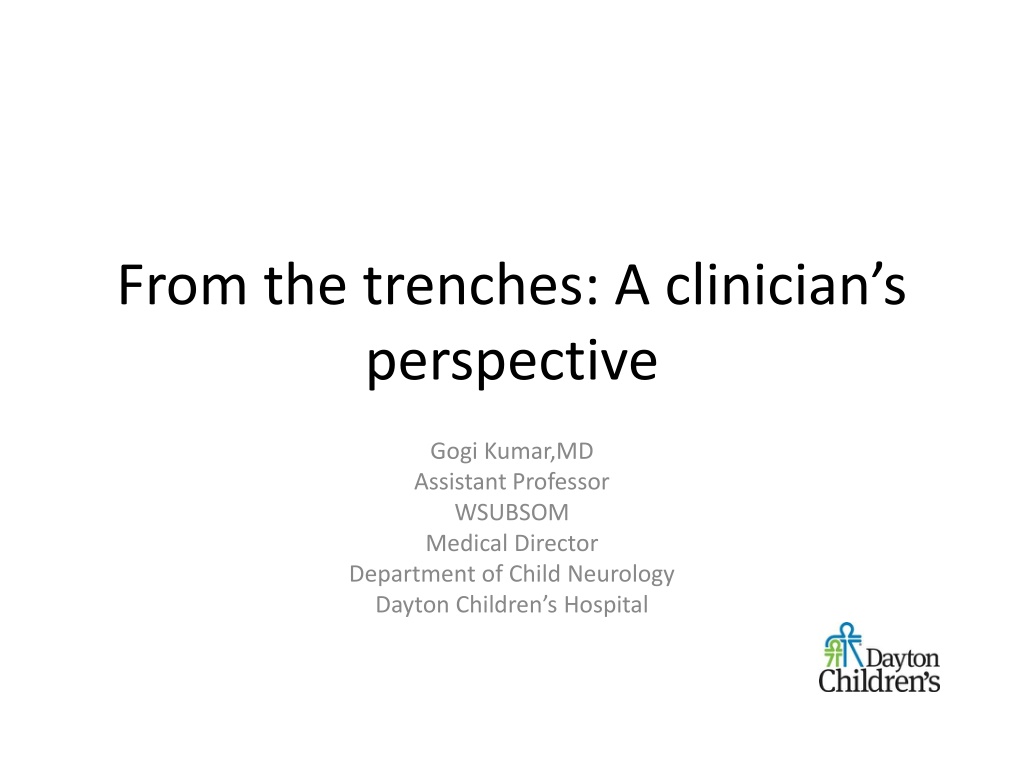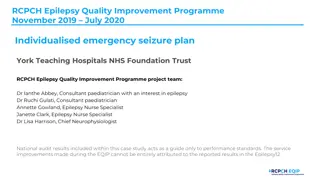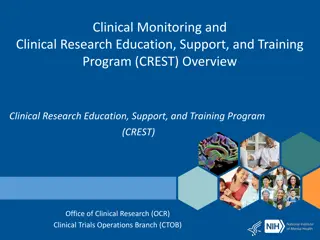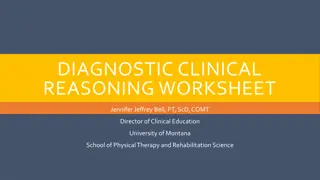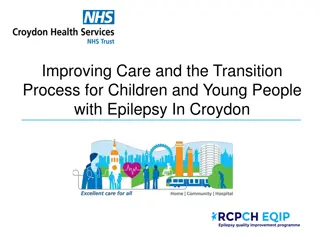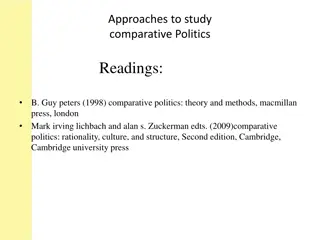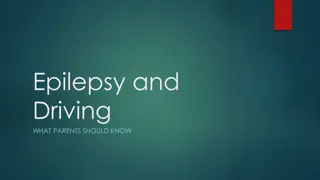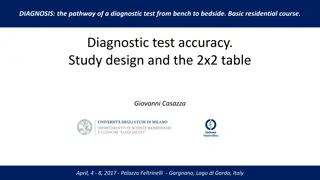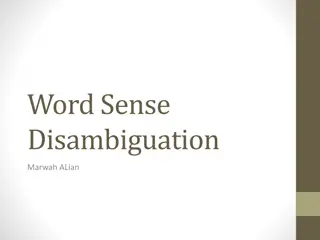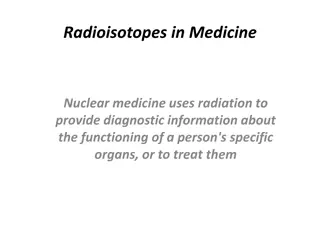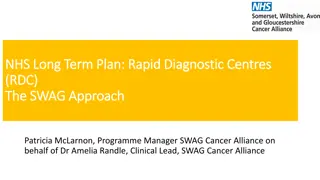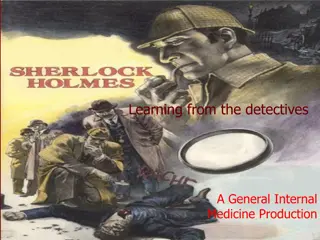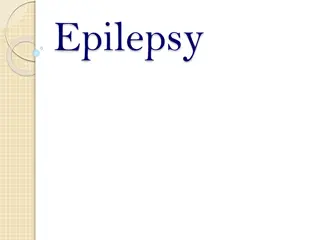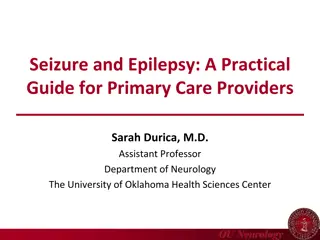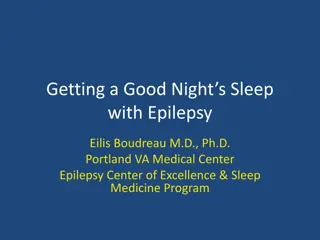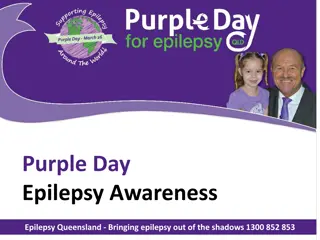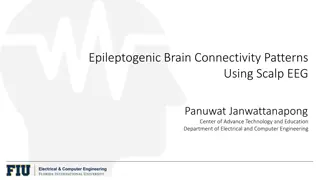Epilepsy: Clinical Insights & Diagnostic Approaches
Clinician's perspective on epilepsy diagnosis, testing, and resolution. Definitions of epilepsy, clinical criteria, and biomarkers for prediction and treatment. Answers to common questions regarding epilepsy testing, treatment options, and monitoring for resolution.
Download Presentation

Please find below an Image/Link to download the presentation.
The content on the website is provided AS IS for your information and personal use only. It may not be sold, licensed, or shared on other websites without obtaining consent from the author.If you encounter any issues during the download, it is possible that the publisher has removed the file from their server.
You are allowed to download the files provided on this website for personal or commercial use, subject to the condition that they are used lawfully. All files are the property of their respective owners.
The content on the website is provided AS IS for your information and personal use only. It may not be sold, licensed, or shared on other websites without obtaining consent from the author.
E N D
Presentation Transcript
From the trenches: A clinicians perspective Gogi Kumar,MD Assistant Professor WSUBSOM Medical Director Department of Child Neurology Dayton Children s Hospital
Case 13 year old with first unprovoked seizure Mom hears a thud in the morning , finds her in the shower having a generalized tonic- clonic seizure Seizure lasts for 2 minutes Sleep deprived
CT scan, urine pregnancy and drug screen is negative EEG:
I diagnose her with new onset primary generalized epilepsy Suggest starting on Lamictal
First Question What is Epilepsy?
Definition of Epilepsy 2005 ILAE definition: 2 unprovoked seizures >24 hours apart Epilepsy is a disorder of the brain characterized by an enduring predisposition to generate epileptic seizures
A practical clinical definition of epilepsy Fisher et al Epilepsia,55(4):475-482,2014 ILAE Task force Epilepsy is a disease of the brain defined by any one of the following: 1.Atleast 2 unprovoked (reflex seizures) occurring >24 hour apart 2.One unprovoked seizure(or reflex)seizure and a probability of further seizures similar to the general recurrence rate (at least 60%) after two unprovoked seizures occurring over the next 10 years 3.Diagnosis of an epilepsy syndrome
2nd Question Can you do any other test to be sure? Blood test? MRI? Does epilepsy get better? How will I know when epilepsy has resolved?
Epilepsy Biomarkers Engel et al Epilepsia 2013 August;54(04)61-69 Biomarker is an objectively measured characteristic of a normal or pathological process. Uses in epilepsy include Predict the development of epilepsy Confirm the presence of epilepsy Measure progression Predict pharmaco-resistance Confirm that the condition is resolved Used to create animal models Reduce the cost of the clinical trial
Epilepsy Biomarkers Electrophysiology Imaging Ictal patterns and interictal spikes Frequencies, duration, source localization, morphology, field size Routine MRI Measures Enhancement (BBB) Functional (FMRI) Spectroscopy (MRS) Diffusion Tensor (DTI) Susceptibility (SWI) High frequency oscillations Activation procedures Photic Stimulation Hyperventilation Sleep Deprivation Drug Induction PET (Positron Emission Tomography) FDG (Deoxyglucose) FMZ (Flumazanil) AMT (alphamethyltryptophane) PK (Inflammation) Excitability TMS (Transcranial Magnetic Stimulation) Direct Electrical Stimulation (Part of Surgical Workup) SPECT (Single Photon Emission Computed Tomography) Engel et al Epilepsia 2013 August;54(04)61-69
3rd Question What kind of epilepsy does my child have? I was reading about seizures while waiting for you to come and see us and read about focal and generalized seizures. Can you tell me more about this?
The Organization of the Epilepsies: Report of the ILAE Commission on Classification and Terminology Ingrid E Scheffer et al For each patient, we should aim to diagnose seizure type(s), electroclinical syndrome and etiology where possible.
Organization of epilepsies Electro clinical syndrome: age of onset, seizure types, EEG patterns, imaging features and co- morbidities such as intellectual impairment Benign is replaced by Self limited She has Genetic generalized epilepsy
Organization of epilepsies Etiological (1) Genetic (2) Structural (3)Metabolic (4) Immune (5) Infectious (6) Unknown
Organization of epilepsies Descriptors of focal seizures according to degree of impairment during seizure* Without impairment of consciousness or awareness With observable motor or autonomic components Focal motor and autonomic can be used Involving subjective sensory or psychic phenomena only aura can also be used Replaces term simple partial seizure With impairment of consciousness or awareness Dyscognitive can also be used. It is understood that dyscognitive may not always mean altered awareness but it is used here to denote altered consciousness or awareness which may be response tested Replaces term complex partial seizure Evolving to a bilateral convulsive seizure May include tonic, clonic or tonic and clonic components in any order Replaces term secondarily generalized seizure
Question no 4 Are you sure it is generalized and not focal?
Focal abnormalities in idiopathic generalized epilepsy Seneviratne et al Epilepsia,55(8);1157-1169,2014 Aura:25% to 54%, visual/epigastric/preictal prodromal symptoms Focal semiology:35%to 46% include head version/eye version/focal myoclonic jerks Absence seizures: Automatisms are common during hyperventilation EEG: Focal interictal abnormalities found in 1/3rd
Focal abnormalities in idiopathic generalized epilepsy Seneviratne et al Epilepsia,55(8);1157-1169,2014 Cortical focus theory : Cortical focus within the perioral regions of somatosensory cortex led the thalamus by a mean of 8.1 m sec during the first 500ms of an absence seizure. Important to differentiate Idiopathic generalized epilepsy from focal frontal lobe epilepsy with secondary bilateral synchrony.
Question no 5 When will she grow out of this? How will I know?
Resolution of epilepsy Fisher et al Epilepsia,55(4):475-482,2014 ILAE Task force Epilepsy is resolved for individuals who have an age dependent epilepsy syndrome and are now past the age Seizure free for the last 10 years with no seizure medication for the last 5 years.
Long-Term Outcome in Epilepsy with Grand Mal on Awakening: Forty Years of Follow-up Holtkamp et al, Annals of Neurology Volume 75,Issue 2 February 2014 42 patients with Epilepsy with Grandmal on Awakening (EGMA) Follow up of 40.1 +/- 12.6 years(range=20-62).26 of 42 patients with EGMA (61.9%) were in 5 year terminal remission. Out of the 26 patients 21 were still taking AEDs and 5 had been completely off medications. Age at the time of investigation was the only independent predictor for seizure freedom. 35.7% in patients younger than 55 years,66.7% in patients between 56 and 65 years and 81.3% in patients older than 65 years. AED withdrawal was done in 45.2% patients and 63.2% of them had a relapse 47.6% had an university degree and 88.1% were regularly employed.
Natural course and predictors of spontaneous seizure remission in idiopathic generalized epilepsy :7-27 years of follow up Podewelis et al Epilepsy Research (2014)108,1221-1227 15 IGE patients who refused treatment Mean duration of follow up was 15.3 years 5 patients had CAE,5 patients had EGCTS,4 patients had JAE (absence +GTCS), 1 patient had CAE Mean age of onset of epilepsy was 15.3 years, mean duration of epilepsy was 18.3 years and mean duration of follow up was 15.3 years Remission rate was 80% in CAE,60% EGTCS and 20% with IGE with ABS/GTCS. Photoparoxysmal response was found in 20% of the patients and it was a poor prognostic factor
Juvenile myoclonic epilepsy 25 years after seizure onset : A population based study Camfield et al Neurology 2009,73;1041-1045 23 patients Age at first seizure 10.4+/-4.3 years Mean follow up of 25.8 years Average age at follow up was 36 years 11 (48%) no longer received AEDs, 6 of these were seizure free,3 had myoclonus only and 2 had rare seizures 12 received AED treatment at the end of follow up 1/3 rd grew out of their troublesome seizures.17% free of all seizures.
Question no 6 Will she have a normal life?
Psychosocial complications in Adult Life Epidemiologic aspects: Lost in transition Camfield et al Epilepsia,55(Suppl.3):3-7,2014 Nova scotia cohort IGE Psychiatric diagnosis (27%) High school graduation (40%) Pregnancy outside stable relationships (38%) Living alone (23%) Unemployment(33%) Criminal conviction (7%)
Behavioral changes in Pediatric epilepsy syndrome JME Impaired abstract reasoning, cognitive speed and planning Janz noted an engaging but emotionally unstable, fairly immature personality, wavering between camaraderie and mistrust, which may lead to difficulties in social adaptation
Death in children with epilepsy Children with an underlying neurological disorder sufficient to interfere with daily activities have a death rate of 25% (Nova scotia study) Risk of SUDEP in children without neurological disorders is same as general reference population (Nova scotia study)
Long-Term Mortality in Childhood-Onset Epilepsy Matti Sillanp , M.D., Ph.D., and Shlomo Shinnar, M.D., Ph.D. N Engl J Med 2010; 363:2522-2529 December23,2010 245 Finnish children with epilepsy, after 40 years of follow-up, 60 subjects had died (24%), a rate three times as high as the expected age- and sex- adjusted mortality in the general population. A total of 33 of 60 deaths (55%) were related to epilepsy A remote symptomatic cause of epilepsy associated with an increased risk of death as compared with an idiopathic or cryptogenic cause (37% vs. 12%, P<0.001). Risk for SUDEP was 7% at 40 years overall and 12% not in long-term remission and not receiving medication.
Cumulative Risk of All Epilepsy-Related Deaths and Sudden, Unexplained Deaths in Subjects with Epilepsy. Sillanp M, Shinnar S. N Engl J Med 2010;363:2522-2529
Cumulative Rate of Death According to Cause of Epilepsy. Sillanp M, Shinnar S. N Engl J Med 2010;363:2522-2529
Conclusions Childhood-onset epilepsy was associated with a substantial risk of epilepsy-related death, including sudden, unexplained death. The risk was especially high among children who were not in remission.
